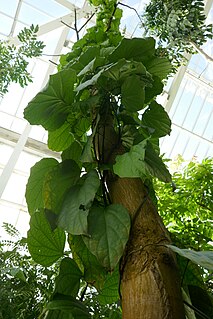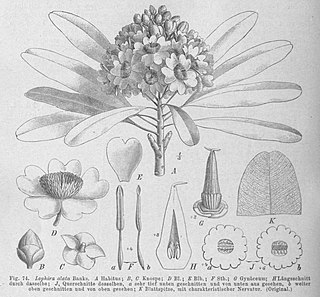
Calophyllum inophyllum is a large evergreen plant, commonly called tamanu, oil-nut, mastwood, beach calophyllum or beautyleaf. It is native to tropical Asia and Wallacea. Due to its importance as a source of timber for the traditional shipbuilding of large outrigger ships, it has been spread in prehistoric times by the migrations of the Austronesian peoples to the islands of Oceania and Madagascar, along with other members of the genus Calophyllum. It has since been naturalized in regions in the East African coast. It is also a source of the culturally important tamanu oil.

Ziziphus mauritiana, also known as Indian jujube, Indian plum, Chinese date, Chinese apple, ber, and dunks is a tropical fruit tree species belonging to the family Rhamnaceae. It is often confused with the closely related Chinese jujube, but whereas Z. jujuba prefers temperate climates, Z. mauritiana is tropical to subtropical.
Newtonia paucijuga is a species of flowering plant in the family Fabaceae. It is found in Kenya and Tanzania.

The Cuban dry forests are a tropical dry forest ecoregion that occupies 65,800 km2 (25,400 sq mi) on Cuba and Isla de la Juventud. The ecoregion receives 1,000–2,000 mm (39–79 in) of rainfall annually. Cuban dry forests can be differentiated into evergreen forests, semi-deciduous forests, mogotes, and sclerophyllous low forests.

Parinari excelsa, the Guinea plum, is a species of large, evergreen tree in the family Chrysobalanaceae. It has a very wide distribution in tropical Africa and South America. This species grows to 50 m (160 ft) tall while the trunk is up to 1.5 m (5 ft) in diameter.

Strombosia pustulata is a species of tree in the family Olacaceae. It is native to the rainforests of tropical West and Central Africa. Common names for this tree include itako in Nigeria, afina in Ghana, poé in Abé spoken in Côte d'Ivoire and mba esogo in Equatorial Guinea.
Erythrophleum ivorense is a species of leguminous tree in the genus Erythrophleum found in the rainforests of tropical West and Central Africa. The tree has many uses; the timber is used for heavy construction, for making charcoal and for firewood, the bark is used for tanning and in traditional medicine, and both bark and seeds are poisonous and used for hunting.

Lannea welwitschii is a species of tree in the family Anacardiaceae. It is native to the tropical rainforests of West and Central Africa. The timber is used to make furniture and utensils and for many other purposes, the fruits can be eaten, and the bark is used to produce a dye, for making rope and in traditional medicine.

Lophira lanceolata, commonly known as the dwarf red ironwood, is a species of tree in the family Ochnaceae which is native to tropical West and Central Africa. The timber is used for heavy construction, an edible oil can be extracted from the seeds and various parts of the plant are used in traditional medicine.
Daniellia oliveri is a species of tree in the family Fabaceae. It is native to tropical West and Central Africa and is commonly known as the African copaiba balsam tree, or the West African copal tree.

Gilbertiodendron dewevrei is a species of tree in the family Fabaceae, native to tropical rain forests in Central Africa. It is often the dominant tree species of the Guineo-Congolian rainforest. The timber is traded as limbali, and is used for construction, flooring and railway sleepers. It is also used for making boats, furniture, tool handles and joinery and for making charcoal.

Brachystegia laurentii, a plant in the family Fabaceae, is a species of large tree found in western Cameroon, Gabon, Equatorial Guinea, the Democratic Republic of the Congo and the Republic of the Congo. It has a dense, umbrella-shaped crown. The wood is known as bomanga and has many uses in building and construction.
Julbernardia seretii, commonly known as the Congo zebrawood, is a species of legume in the family Fabaceae. It is found in tropical West and Central Africa.

Drypetes arguta, commonly known as the water ironplum, is a species of small tree or large bush in the family Putranjivaceae. It is native to tropical East Africa. It was first described in 1920 by the English botanist John Hutchinson, who named it Cyclostemon argutus. It was later transferred to the genus Drypetes.
Anthostema madagascariense is a species of flowering plant in the family Euphorbiaceae. It is a small to medium-sized tree or large bush, endemic to Madagascar, the Comoro Islands and Mayotte.
Pouteria adolfi-friedericii is a species of plant in the family Sapotaceae, a tall, tropical forest tree. It is found in Burundi, the Democratic Republic of the Congo, Ethiopia, Kenya, Malawi, Rwanda, Sudan, Tanzania, Uganda, Zambia and Zimbabwe. The specific name adolfi-friedericii was given in honour of Duke Adolf Friedrich of Mecklenburg, a German explorer in Africa. Its trade name muna is taken from Gĩkũyũ mũna.
Drypetes gerrardii is a species of small tree or large shrub in the family Putranjivaceae. Common names include forest ironplum, bastard white ironwood, and forest ironwood. It is native to tropical and subtropical central and eastern Africa. It was first described in 1920 by the English botanist John Hutchinson, who named it after the English botanist William Tyrer Gerrard who collected plants and seeds in southern Africa in the 1860s.
Guibourtia tessmannii is a species of legume in the family Fabaceae. It is a medium to large-sized tree and is native to Cameroon, Gabon and Equatorial Guinea. The timber has an attractive appearance and has many uses, and the bark is used in traditional medicine.

Humbertia is a monotypic genus of flowering plants belonging to the family Convolvulaceae. It only contains one species, Humbertia madagascariensisLam. It is native to Madagascar. It is known in French as bois de fer; it is endemic to southeastern Madagascar where it occurs in humid evergreen forests at altitudes up to about 600 m (2,000 ft).

Berlinia grandiflora is a small to medium sized three found in the West and West Central African region along riparian habitats or gallery forests habitat types.











